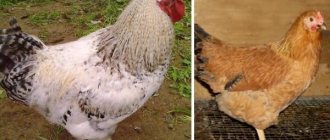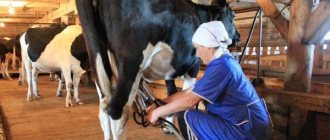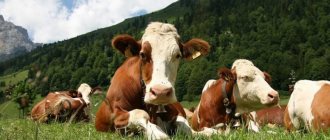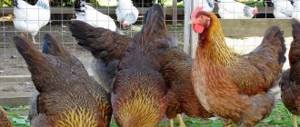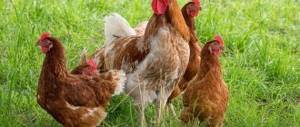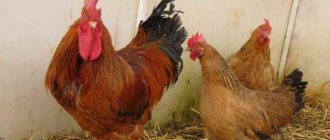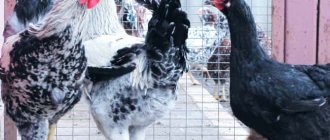Home » Domestic chickens » Crosses and breeds of chickens » Wyandotte chickens
Wyandotte is a breed of chicken that is deservedly considered one of the most beautiful in the poultry yard. It is worth adding excellent egg and meat productivity to its attractive appearance, and Wyandotte can lay claim to the title of an ideal backyard bird.
Description of the breed
| Breed name | Wyandotte |
| Other name | No |
| Productivity direction | Meat-egg breed |
| Average weight | 3.2 kg |
| Average egg production, eggs per year | 200-210 |
| Maturation of pullets, months | 5 |
| Egg size, g | 60-65 |
| Eggshell color | Brown |
| Feathered legs | No |
| Tendency to brood | Moderate |
| Demandingness | Unpretentious, tolerate cold well |
| Bantam shape? | Eat |
| Should a newbie start one? | Yes |
The medium-sized, dense bird is distinguished by remarkable egg production for a breed of universal use, which is easy to conclude just by looking at these well-proportioned laying hens with ideal proportions.
On average, a Wyandotte hen lays about 200 large brown eggs per year, starting to lay quite early - at the age of 5 months, and sometimes a little earlier.
Wyandotte forms a round, heavy carcass by the age of 5-6 months. The table quality is excellent - the meat is white, tender, fine-fiber, juicy.
The average weight of an adult rooster is up to 3.8 kg, chickens – about 2.7 kg.
The dwarf form of the Wyandotte breed was created through the efforts of German breeders. Hens weigh about 900 g, cockerels - up to 1 kg. Egg production is small - about 100-120 eggs per year.
Breeding
Learning to breed Wyandottes is not easy. In this case, the breeder faces a number of problems:
- It is necessary to master the skills of breeding the required colors, in addition, take into account that selection is fixed on both the paternal and maternal lines. To do this you need to use a color calculator. But it only gives an approximate direction, since there are many hybrids of this breed.
- Breeders recommend avoiding the possibility of obtaining inbrids (crossing within the population), this reduces immunity, egg production and spoils the exterior. This is not easy to do, given that only two lines of Wyandottes are common in Russia - from Poland and from Germany.
- Buying a hatching egg - standard and dwarf eggs differ little from each other in color and size.
- Buying young chickens - the colors of newly hatched chicks can be quite varied. What color an adult bird will be can be found out only after the first molt.
Wyandottes are bred on farms to preserve genetic material for breeding crosses.
Removal methods
Chicks are hatched both in incubators and naturally. In this they are no different from other breeds of chickens; there are no special requirements for the process.
Eggs selected for incubation must weigh at least 55 g and have a smooth and undamaged surface. They should be stored for up to 14 days in a cool place.
During natural incubation, so many eggs are placed under the chicken so that they are completely hidden under it in one layer. The hen will hatch them for 20-21 days. And then, she will take on the responsibilities of caring for the chicks. All that remains for the breeder is to provide the necessary food and clean water on time.
When incubator breeding, the following sequence is followed:
- the incubator is heated to 25 °C (this is considered room temperature);
- the eggs are brought into the room in which the incubator is installed so that they warm up to the room temperature;
- the eggs are placed in the incubator and the temperature is set to 39 °C;
- on day 12 the temperature is reduced to 38.5 °C;
- from the 19th day until hatching (20-21 days) the temperature is maintained at 37-38 °C.
Once hatched, chicks should be kept in a brooder and the temperature controlled. Or you can put it on a hen, if you have one (the chicken can be of any breed).
From 2 weeks of age, chicks are placed on open grass for 15-20 minutes. You can equip a covered, draft-proof enclosure specifically for young animals. It is important that the walking area has both sun-warmed and shaded areas. Walking time is increased gradually.
After fledging, the chickens are transferred to a common chicken coop, but the roosting area must additionally be heated using an infrared lamp if the young are raised without a hen.
Chickens are fed boiled eggs mixed with semolina or starter feed until they are one month old. Afterwards, add herbs, dairy products, mixtures of meat and fish waste.
Appearance of chickens
In addition to all its excellent performance characteristics, the Wyandotte is a stunningly beautiful bird. Being medium in size, the breed appears a little bulky due to its lush, dense plumage. The tail of chickens is small and neat, while that of roosters is more magnificent, located at an angle of 40°. The pink comb, small rounded earlobes and earrings are red. The eyes are bright, amber in color. Legs are yellow.
The main color of the plumage in most cases is complemented by a contrasting edging of each feather, which gives the chickens exceptional attractiveness.
The original plumage color is silver, which remains the most popular variation today. Shiny wide cover feathers of silvery-white color are trimmed with a clear black border with a green gloss.
In addition to the original silver, there are 16 more recognized colors of these chickens and each amazes with its catchy and at the same time exquisite beauty, the most common are: bordered - golden, lavender, blue, buff; silver outlined (with thin black edging), partridge, buff, blue, black and white.
Reviews from Wyandotte owners
Igor Anashkin, Vorontsovka village
I once saw these chickens in a photograph and caught fire. I have been looking for access to breeding breeding centers for a long time. Finally we managed to get eggs of the classic “silver-edged Wyandotte” variety. The bird is truly amazing. Its disadvantage is its reluctance to move a lot, like other chickens. Because of this, it is necessary to strictly monitor the diet of the Wyandots so that they do not become obese. On the other hand, due to their sedentary lifestyle, less feed is consumed than other chickens. You also need to monitor the food and add more animal proteins and calcium. Otherwise, there is no hassle with this breed.
Sergey Gumenyuk, Oktyabrsky village
The bird is simply wonderful. Our winters are cold, but the Wyandots don’t care. Of course, you can’t keep them completely in the snow, but in a cold chicken coop they overwinter just fine. Of course, egg production in this case decreases. If you want eggs, raise the temperature to at least 10 degrees. Another bad thing for me is that the Wyandottes turned out to be of different colors. I won’t be able to do pure breeding, the livestock is too small, and if mixed from parents of different colors, anything can come out.
Chicken Temperament
This beautiful bird is friendly and gets along well with people. Chickens are easily tamed, having gained the experience of affectionate and patient communication with humans from a young age. They are magnificent hens and reverent mothers.
Despite its peaceful disposition, Wyandotte has a bright personality and in a mixed flock of poultry, chickens tend to dominate their companions of other breeds and species. Roosters are generally peaceful, but will tirelessly defend their harem and territory from the encroachments of strangers.
Chickens are somewhat noisy and like to loudly discuss everything that happens.
At the same time, this is an incredibly positive bird that will decorate any yard and add a touch of homeliness and comfort. Wyandotte chickens and rooster
Character
Chickens of the Wyandotte breed are distinguished by a particularly accommodating, peaceful character. Birds live equally well with representatives of their own breed and other birds, even such small ones as pigeons and quails.
The breed is not shy; the bird is very willing to contact humans. The birds quickly get used to the owner and soon after appearing in the house they begin to respond to the call. If you actively communicate with them, then pets often begin to follow simple commands, which is especially popular with young children.
Content Features
Luxurious plumage, decent weight and a small comb make the Wyandotte breed resistant to adverse weather conditions and therefore a good choice for owners living in cold regions.
It will not be difficult for strong birds to fly over a low fence, but they are still somewhat lazy and will most likely remain sitting on the fence, looking around the yard from above with the owner’s sharp eye.
This bird does not tolerate being kept indoors very well and it is advisable to give them free range as they are excellent foragers.
Chickens are good brood hens, but the hen needs to be given a separate corner to quietly incubate the chicks, otherwise she can become nervous and even aggressive.
Roosters are active, but when treated calmly, they usually do not behave hostilely, being condescending towards other birds and people.
Maintenance and care
The Wyandotte, Bielefelder, and Leghorn breeds do not require special care, the only exception being bird feeding. The productivity of the breed directly depends on the quality of feed and care. Due to the wide genetic base used in breeding, climatic conditions are not important for these birds; they adapt to any weather. For the proper development of birds it is necessary to organize:
- a spacious chicken coop with an area of 1 square meter for 3-4 birds;
- warm nests for laying hens located at a level of 30-40 cm above the floor;
- uniform bedding of chopped tree bark or sawdust;
- ventilation and lighting system;
- an area for walking in the warm season with fences no lower than 1.5 meters;
- heating (necessary in regions with harsh climates and frosts below -15 degrees). This article will tell you about the Hungarian Giant chicken breed.
This breed is inactive and quite voracious, so keeping it must be combined with walking.
Do-it-yourself perches can be installed at your discretion; in general, the breed is also adapted to outdoor living. In any case, cleanliness is much more important; clean the chicken coop at least 3 times a week. This article will tell you about the Rhode Island chicken breed.
Feeding
This breed suffers from obesity, therefore combined high-calorie feeds are not suitable for fattening Wyandottes. From the first days of life, the diet of birds differs from the food of other species. At 1 week, chickens should be fed boiled eggs mixed with semolina. In the second week, low-fat cottage cheese and fresh herbs are included in the diet.
From 3-4 weeks of life, the diet of the entire livestock consists of:
- whole grains (oats, wheat, barley);
- mineral supplements (crushed shells, ground egg shells, feed chalk);
- herbal mixtures (clover, alfalfa, nettle);
- pine flour.
It is important not to overfeed the birds; food is supplied twice a day. Do not forget about clean drinking water; it must be present in the chicken coop at all times.
Advantages and disadvantages of the Wyandotte breed
| Advantages of the breed | Disadvantages of the breed |
|
|
Prospects for breeding the Wyandotte breed in Russia
Wyandotte chickens are suitable for harsh winter climates. The ability to withstand frost and low mortality of offspring allows you to quickly recoup costs. The chickens grow without the active control of the owner and are in demand.
It is worth breeding Wyandottes as an ornamental show breed due to the variety of colors. This is complicated by the low representation of the breed in Russia, because selection requires representatives of different lines.
Farmers who have purchased purebred Wyandots leave extremely positive reviews.
It is quite difficult to acquire a purebred representative, but if the opportunity arises, you need to spend money.
History of the origin of the breed
The exact origin of the breed is difficult to establish. It is known that the first mention of it appeared in 1860. Then admiring admirers gave the new breed the name American Seabright, later calling it Excelsior, in honor of the famous diamond.
Most likely, Wyandot originates from the Cochin and Seabright breeds. Experts agree that Brahms and Hamburg speckled chickens were also involved in the selection.
The Wyandotte chicken breed received its sonorous name in honor of the ship of the owner of the first purebred individuals.
Problems with breeding
In fact, the problems are not with breeding this breed, but with the purchase of purebred birds. Purebred Wyandottes are practically never found on private farmsteads and you should not count on purchasing high-quality livestock from private hands. In breeding centers, Wyandotte is preserved as genetic material for breeding new breeds or crosses. If you manage to get a hatching egg of purebred Wyandottes, the cost of purchasing it will quickly pay off in the future. Wyandottes have a very high chick hatching and survival rate.
Reviews about the breed
Review from: Nadezhda Viktorovna Polskikh, Vinnitsa region, Ukraine.
Pros: very beautiful, wears well
Cons: none.
We decided to get a purebred bird three years ago - we ordered four silver Wyandottes from Poland - three hens and a rooster, and four Rhode Island reds - two pairs. And although all the birds were adults, there were no problems with maintenance either then or now. One Rhode Island rooster died in an accident. The Wyandots were laying great, now those hens slowed down a little, but a year later one hen sat on the eggs - and gave birth to seven excellent large chickens.
Now we keep a flock of twelve Wyandots - eleven hens and one rooster, which is enough for us. I recommend and praise it to everyone - a beautiful, calm bird, I look at it and relax my soul.
Review from: Ivan Kostyukov, Saratov, Russia.
Pros: gorgeous bird, affectionate, good brood hens.
Cons: It's a shame to cut!
We have a flock of fifteen Wyandots, beautiful different colors - partridges are our favorite. They are frost-resistant and winter in our barn without any problems. The rooster is handsome, but at the same time caring and masterful, and has never attacked anyone.
Chickens older than two years old cluck and hatch chicks every year. We leave the chickens and the cockerels for meat. One thing is bad - it’s a shame to kill a bird. Painfully good! The neighbor says that yours are pheasants. There is no better bird than the Wyandottes!
Dear readers, you have the opportunity to add a review about the breed to the article. To do this, write your detailed comment using the contact form and in the near future it will be transferred to the text of the article. If you are a breeder of purebred chickens and sell young stock or eggs, you can include this information, but do not forget to indicate your region of residence.
Reviews from poultry farmers
Larisa, 36 years old, Kaliningrad region
We breed Wyandotte birds in two colors (silver and golden). Eggs were brought from Poland and hatched through an incubator. The first time was difficult; we warmed the chickens with an infrared lamp, gave them food by the hour, and survived an attack by the neighbor’s dogs. Everything worked out well, and in the end not a single chicken was harmed. We are very pleased with the breed, egg production is high, eggs and meat are delicious. They promised to bring us black ones, we are looking forward to it.
Maxim, 30 years old, Belgorod
I have been training this breed for three years. I have the most positive opinion about them - calm, peace-loving, doing their job. They can stand up for themselves. The gray crow tried to steal the chicken, so the rooster taught her a lesson - only the feathers flew, she will no longer want to rob. I feed them with mixed feed and corn, we dig up the plot together and they are not afraid of the cultivator.
Anna, 24 years old, Nizhny Novgorod region
At first I didn’t dare to get Wyandottes, but my husband persuaded me (he’s my forester). I read everything I could find about them on the Internet and “got excited”, then they infected me too. These are miracle chickens! I don’t know what is more in them - decorative or useful, but rather both. Unpretentious, they are not very afraid of cold weather. There is no more hassle with them than with other chickens. The kids loved them very much and nursed them from the cradle.
Breeding chickens
About half of the laying hen population, starting at six months of age, begins to hatch eggs. Each Kucha breed can hatch and raise 13-15 chickens without any problems, but you can try laying up to 27 eggs.
Smart, active chicks are born practically without any physiological abnormalities.
Hatchery chicks may experience the following problems:
- the embryo may freeze in the egg and not hatch;
- the chicken may hatch with the umbilical cord wrapped around its foot, which does not allow it to absorb the remaining yolk and deprives it of strength for further growth;
- farmers notice pecking of incubator eggs, which leads to the death of the embryo.
Material selection and incubation
Egg selection occurs according to the following parameters:
- eggs are carefully selected - correct shape, medium size, without cracks or growths;
- carefully clean them, but do not wash them (if you wash off the shell film, the eggs will be unsuitable for incubation or incubation);
- store eggs in a cool place and in clean containers;
- Incubation material can be collected for no more than 2 weeks.
The organization of hatching involves the following steps:
- The nest is located in a cool, secluded place, away from other nests.
- The size of the nest should be 40x40 cm, cover it with straw or hay.
- Place the eggs in the nest in one row in a horizontal position.
- The eggs are turned over to prevent the embryo from sticking every 2-3 days.
- After a week, the eggs are checked for the presence of an embryo; if not, they are removed.
- The hen is fed every day mainly with dry food, and is also provided with free access to water.
Hatchery hatching involves the following sequence:
- The device is disinfected and turned on a day before laying the eggs.
- The eggs are brought into a room where an incubator is installed to gradually warm them to room temperature.
- The eggs are placed in the incubator, the temperature is set to 37.9 °C, and the humidity is 66%.
- The eggs are turned 4 times a day until the 12th day.
- From the 13th day, reduce the temperature to 37.3 °C, humidity to 53%.
- Coups are carried out in the same number. The incubator is ventilated 2 times for 5 minutes.
- From the 18th day, humidity is reduced to 47%.
- Turn the eggs 4 times, air them 2 times for 20 minutes.
- 20-21 days - reduce the temperature to 37 ° C, raise the humidity to 66%, stop turning the eggs, ventilate for 5 minutes twice.
After 21 days, the chicks are born; the process takes several hours.
After birth
The following steps should be taken when hatching chicks:
- the chickens are transferred to a warm place (box), where the temperature is maintained at 25-28 °C at the edges, 34 °C under the lamp;
- after the appearance of the first plumage, the temperature is reduced by 3 degrees every week;
- at the end of the first month, the temperature of the chickens is reduced to 20 °C.
At the age of 5-6 days, chickens are released for walking in warm weather. At first the time should be 5 minutes and gradually increase. To do this, it is better to equip a special enclosure for young animals.
Diet
From the first days of life, chickens are offered chopped boiled eggs with semolina at the rate of 1 egg per 25 chickens.
Next enter:
- vegetables (boiled potatoes, carrots);
- greenery;
- cottage cheese;
- additives (bone meal, fish, coal, chalk, coarse sand).
From 2-3 weeks, chickens are introduced to grains and cereals. At first they are ground.
After a month, the chickens can be kept together with adults.
Characteristic
Wyandottes have an extremely bizarre appearance and can be confused with other breeds. However, becoming familiar with the standards set by veterinarians will help you select healthy purebreds to successfully breed high-producing birds. If you are a beginning farmer, carefully consider all the advantages and disadvantages, analyze possible difficulties, so that the features of care do not become an unpleasant surprise (as well as unexpected changes in productivity).
Appearance and standards
Wyandotte chickens have a specific appearance that makes them stand out from other laying hens. Distinctive features are:
- variegated color of large feathers that fit tightly to the body. In the classic version, the middle part of the feather is white and bordered by a silver-black stripe. There are also golden-red and pure black specimens;
- the body is rounded, the keel is poorly defined, the skeleton and muscles are well developed;
- The tail feathers of hens are white, those of roosters are motley (depending on the main color of the plumage), the braids do not appear;
- small black eyes surrounded by red bumpy skin;
- the body is disproportionate: small head, long neck, straight elongated body and long legs;
- the legs are powerful, strong, covered with dense pale yellow skin;
- the comb is small, the teeth do not stand out, the earrings are voluminous and bright red.
When purchasing chicks that differ in appearance from adults, carefully examine their muscles. Young animals at an early age have a strong build, well-developed legs and wings. The color of the chickens is uneven, although there are no variegated main feathers yet.
Character
The Wyandotte breed is distinguished by its pliable, friendly character, which can be considered a significant advantage for a bird. Several roosters can coexist in the same territory without fighting or displaying aggression. Also, thanks to its calm disposition, it can be kept together with representatives of other species. Find out why you need a rooster in a chicken coop here.
The only disadvantage of the breed is their lazy behavior.
Wyandots are often at risk of obesity due to their sedentary, measured lifestyle. To avoid this problem, organize a walking space and a system of perches of different heights.
Origin
American breeders have been working on this breed for several decades. The final copy was received in 1883. Several of the most productive breeds common in North America were taken as a basis: Leghorn, Cochiquin, Dorking, Orpington and Bentham Seabright. The birds arrived in Europe a year later, but in Russia they became known only in 1911. Despite the success in breeding Wyandots (this name is of Indian origin), work on the breed continued for many more years. Today, about 15 subspecies are known, differing in plumage color, body size, and productivity. Also read about Brahma chickens at this link.
Advantages and disadvantages
The main one is the tendency to obesity, which worsens the taste of meat.
These crosses have many advantages:
- ability to adapt to new conditions;
- delicious meat, tender and soft;
- fertility, large broods both during natural hatching and in the incubator;
- good health in all weather conditions;
- good egg production rates.
